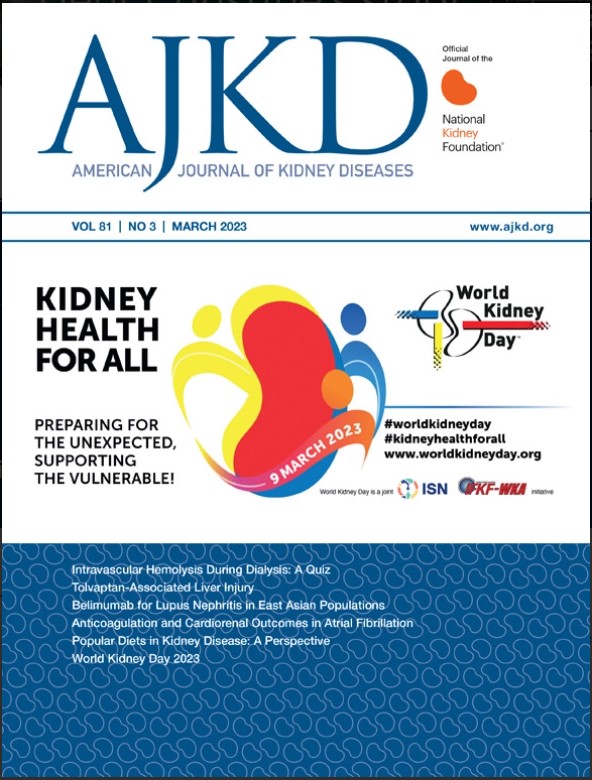基于运动的肾移植预备康复:FRAILMar随机对照试验。
IF 8.2
1区 医学
Q1 UROLOGY & NEPHROLOGY
引用次数: 0
摘要
理由与目的肾移植(KT)是肾衰竭的首选治疗方法,但移植后存在显著风险,特别是对体弱患者。本研究评估了以运动为基础的康复计划对KT候选人运动能力、肌肉功能和肌肉大小的影响。研究设计:分析frrailmar研究的功能结局,这是一项随机对照试验。情景与参与者121位KT候选者在KT等候名单上。干预组接受24次训练(1小时,每周3次,持续8周),对照组接受标准治疗。随机分组按虚弱状态分层。主要结果是在心肺运动试验中通过最大工作量评估运动能力。次要结局包括外周肌功能、呼吸肌功能、肌肉大小和虚弱状态的改变。结果121例患者的平均年龄为63.4岁,76%为男性,40%体弱(Fried表型≥2)。106例患者完成了预康复计划,其中,与标准治疗相比,预康复显著提高了运动能力(+12.8 watts;[95% CI: 3.4 ~ 22.2];P =0.008),握力(+1.8 kg;[95% CI: 0.7 ~ 2.8];P <0.001),股直肌厚度(+1.2 mm;[95% CI: 0.3 ~ 2.0];p = 0.007)。体弱患者在大多数指标上都有显著改善,表明这一亚组有潜在的益处。尽管结果是预先指定的,但由于随访时间短和多次比较导致I型错误的风险,该分析受到了限制。结论为期8周的运动康复计划可以改善KT候选人的运动能力、肌肉功能和肌肉大小,在虚弱患者中也可以观察到效果。这些发现可能为该领域的未来研究和标准化康复方案的价值评估提供信息。本文章由计算机程序翻译,如有差异,请以英文原文为准。
Exercise-Based Prehabilitation for Kidney Transplant Candidates: The FRAILMar Randomized Controlled Trial.
RATIONALE & OBJECTIVE
Kidney transplantation (KT) is the preferred treatment for kidney failure but carries significant post-transplant risks, particularly for frail patients. This study evaluated the effects of an exercise-based prehabilitation program on exercise capacity, muscle function, and muscle size among KT candidates.
STUDY DESIGN
Analysis of functional outcomes within the FRAILMar study, a randomized controlled trial.
SETTING & PARTICIPANTS
121 KT candidates on the KT waiting list.
INTERVENTION
The intervention group participated in a prehabilitation program comprising 24 exercise sessions (1 hour, 3 times per week for 8 weeks), the control group received standard care. Randomization was stratified by frailty status.
OUTCOMES
The primary outcome was exercise capacity assessed by maximal workload during a cardiopulmonary exercise test. Secondary outcomes included peripheral muscle function, respiratory muscle function, muscle size, and changes in frailty status.
RESULTS
The mean age of the 121 individuals who were randomized was 63.4 years, 76% were men, and 40% were frail (Fried phenotype ≥ 2). 106 patients completed the prehabilitation program and, among them, compared to standard care, prehabilitation significantly improved exercise capacity (+12.8 watts; [95% CI: 3.4 to 22.2]; p=0.008), handgrip strength (+1.8 kg; [95% CI: 0.7 to 2.8]; p<0.001), and rectus femoris thickness (+1.2 mm; [95% CI: 0.3 to 2.0]; p=0.007). Frail patients showed significant improvements across most measures, demonstrating potential benefits for this subgroup.
LIMITATIONS
This analysis was limited by a short follow-up period and the risk of type I error due to multiple comparisons, even though outcomes were pre-specified.
CONCLUSIONS
An 8-week exercise-based prehabilitation program may improve KT candidates' exercise capacity, muscle function, and muscle size, effects also observed among frail patients. These findings may inform future research in this area and the evaluation of the value of standardized prehabilitation protocols.
求助全文
通过发布文献求助,成功后即可免费获取论文全文。
去求助
来源期刊

American Journal of Kidney Diseases
医学-泌尿学与肾脏学
CiteScore
20.40
自引率
2.30%
发文量
732
审稿时长
3-8 weeks
期刊介绍:
The American Journal of Kidney Diseases (AJKD), the National Kidney Foundation's official journal, is globally recognized for its leadership in clinical nephrology content. Monthly, AJKD publishes original investigations on kidney diseases, hypertension, dialysis therapies, and kidney transplantation. Rigorous peer-review, statistical scrutiny, and a structured format characterize the publication process. Each issue includes case reports unveiling new diseases and potential therapeutic strategies.
 求助内容:
求助内容: 应助结果提醒方式:
应助结果提醒方式:


